The Toilet Care Wipes Market is estimated to be valued at USD 23.6 billion in 2025 and is projected to reach USD 44.8 billion by 2035, registering a compound annual growth rate (CAGR) of 6.6% over the forecast period.
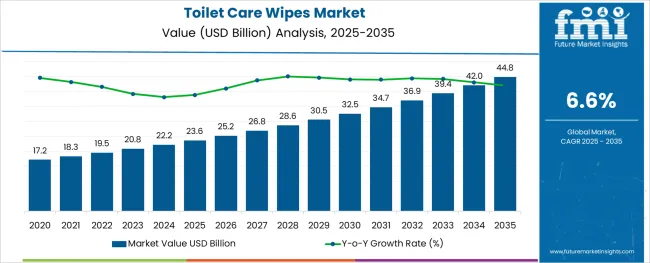
The toilet care wipes market is growing steadily as consumer demand for convenient and hygienic personal care products continues to rise. Increasing awareness of personal hygiene, along with growing concerns about skin sensitivity and irritation, has driven innovation in wipe formulations. The availability of diverse product types, including conventional and eco-friendly options, caters to a broad consumer base.
Retail expansion and increasing penetration of household cleaning products in emerging markets have further propelled growth. Public health campaigns emphasizing cleanliness have supported wider acceptance of toilet care wipes as an essential hygiene product.
The market outlook remains positive with ongoing product innovations targeting gentle, effective cleansing and sustainable packaging solutions. Segmental growth is expected to be driven by Conventional Toilet Care Wipes as the preferred nature segment, Unscented products in the type category, and Household use as the leading end-use segment.
The market is segmented by Nature, Type, End Use, and Sales Channel and region. By Nature, the market is divided into Conventional Toilet Care Wipes and Organic Toilet Care Wipes. In terms of Type, the market is classified into Unscented and Scented. Based on End Use, the market is segmented into Household and Commercial. By Sales Channel, the market is divided into Supermarkets, Hypermarkets, Independent Retailers, Multi Brand Stores, Specialty Retail Stores, Online Sales, Company Website, and 3rd Party Online Sales. Regionally, the market is classified into North America, Latin America, Western Europe, Eastern Europe, Balkan & Baltic Countries, Russia & Belarus, Central Asia, East Asia, South Asia & Pacific, and the Middle East & Africa.
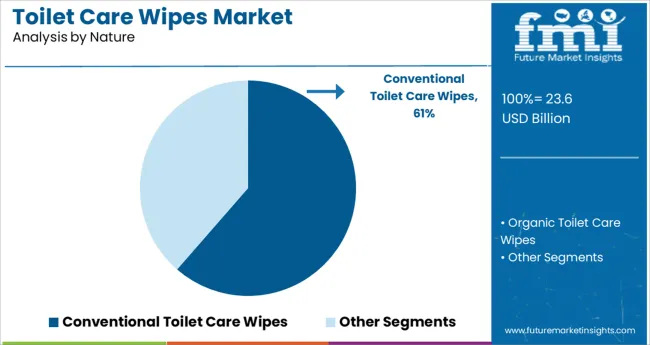
The Conventional Toilet Care Wipes segment is projected to hold 61.4% of the market revenue in 2025, maintaining dominance within the product nature category. Growth in this segment has been driven by consumer trust in traditional wet wipe formulations known for effective cleansing properties. These wipes are widely favored for their consistent quality and availability across retail channels.
Additionally, conventional wipes offer balanced moisture and texture suitable for a wide range of skin types. While sustainable alternatives are emerging, conventional wipes remain popular due to affordability and proven efficacy.
Consumer preference for reliable and convenient cleansing products supports ongoing demand in this segment.
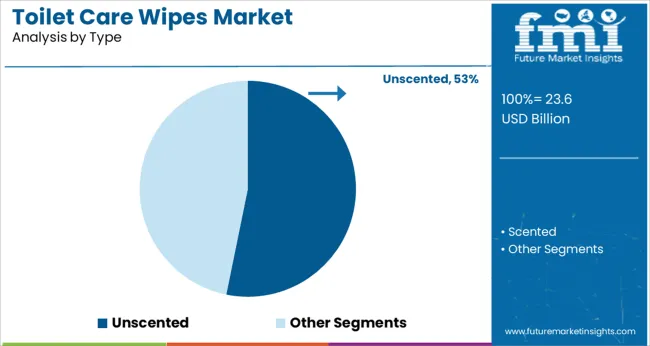
The Unscented segment is expected to contribute 53.2% of the toilet care wipes market revenue in 2025, establishing itself as the leading product type. Growth has been stimulated by increasing sensitivity among consumers toward fragrances and additives that may cause irritation. Unscented wipes provide gentle cleansing suitable for sensitive skin and individuals prone to allergies or dermatological conditions.
This segment has benefited from heightened consumer awareness about skin health and the rise of hypoallergenic personal care products. Market expansion has also been supported by product labeling and marketing that emphasize safety and skin compatibility.
The Unscented segment is likely to maintain its prominence as consumers seek mild and effective personal hygiene options.
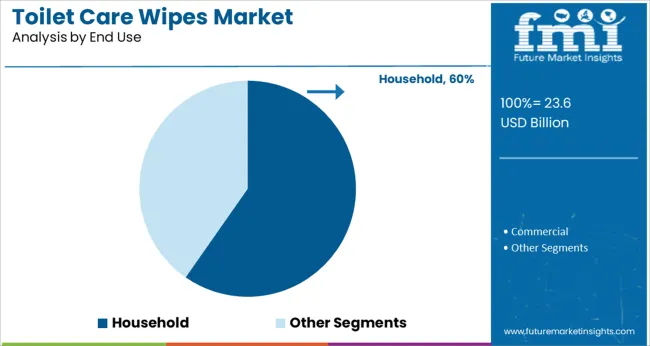
The Household segment is projected to account for 59.7% of the toilet care wipes market revenue in 2025, positioning it as the dominant end-use category. This growth has been fueled by the widespread adoption of toilet care wipes as an everyday hygiene solution in homes.
Convenience and effectiveness have made these wipes a staple in many households, especially among families with children and elderly members. Retail availability through supermarkets, pharmacies, and online platforms has made access easier for consumers.
Additionally, growing hygiene consciousness and lifestyle changes encouraging self-care routines have further expanded household consumption. The Household segment is expected to retain its market leadership as toilet care wipes become a standard hygiene product in domestic settings.
Growing consumer expenditure on health and hygiene products, tied with new product novelty through the usage of novel technologies, is a crucial factor driving the growth of the toilet care wipes market. The sale of personal care products, such as toilet care wipes, is encouraged by the refining quality of lifestyle of consumers.
The supply-side contributors of the toilet care market have pandered in research and development activities for value addition to products, such as long-lasting fragrances, softer surfaces, and efficient cleaning. Mindfulness about the accessibility of products such as toilet care wipes is principally influenced by TV commercials and social media promotion, which play an imperative role in shaping consumer behavior.
Growing concerns regarding environmental issues are likely to act as a key challenge in the global toilet care wipes market. There is an increase in environmental issues, such as deforestation and global warming as a result of tree cutting, which would limit the availability of pulp-based products. In addition, the vast number of locally organized and disorganized tissue product makers has an impact on the businesses of the signs connected corporations.
Furthermore, supply chain disruptions, as well as trade impediments imposed by numerous countries, hamper enterprises’ ability to expand into international markets and stifle market growth. The cost of these assist devices is high, which can hinder users from adopting these devices. Furthermore, a lack of knowledge regarding the availability of such devices can also hamper the global bathroom and toilet assist devices market.
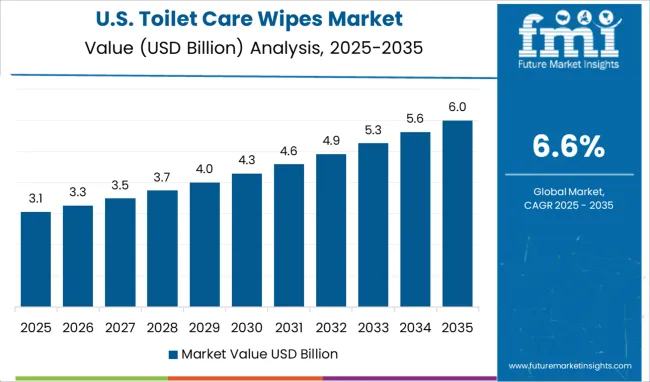
North America accounted for a prominent share of the global bathroom and toilet assist devices market due to the presence of major manufacturers in the region. Rising adoption of technologically equipped devices and increasing life expectancy are major factors driving the growth of the bathroom and toilet to assist devices market in North America.
The United States is the world’s greatest consumer of toilet paper. Because USA customers tend to use too much toilet paper, they use more than a fifth of the world’s toilet paper. Besides this, the country also has the greatest per capita usage of toilet paper in a year. Moreover, the prominent members are innovating new products to reduce water usage and effective cleaning.
In May 2025, INDA announced the three finalists for the World of Wipes Innovation organized in Chicago. The three products vying for the prestigious award are an all-natural substitute for plastic fibers from Bast Fibre Technologies, a dual-textured 3D cleaning wipe from Fitesa, and an environmentally safe flushable wipe from Nice-Pak. Future Market Insights forecasts that the North American market for Toilet Care Wipes is projected to expand at a 6.3% CAGR by the end of 2035.
A recently published report by Future Market Insights revealed that th Asia Pacific wipes market is expected to grow at a CAGR of 6.8% during the forecast period ranging from 2025 to 2035. Wipes are small moist cloth pieces that are consumed for cleaning surfaces. They are meant to reduce the usage of cloth, paper, or any other liquids used for wiping.
These wipes are used for light rubbing or friction wiping to remove dirt or liquid from the surface. They benefit by facilitating a convenient way of maintaining personal hygiene.
Apart from keeping personal and household hygiene, wet tissues, and wipes also display antibacterial, exfoliating, and moisturizing properties. Besides, increasing concerns related to personal hygiene and the swelling influence of social media and other promotional media have increased consumer awareness about health and hygiene products in the APAC region.

Some of the key players in the Toilet Care Wipes market are Redcliffe Hygiene Private Limited, Pure Touch Skin Care, Bodywise (UK) Limited, Tesco PLC, Walmart Inc., Kimberly-Clark Corporation, Dude Products, Inc., Parent's Choice Infant Formula, The Procter & Gamble Company and Costco Wholesale Corporation, among others. Recent key developments among players include:
| Report Attribute | Details |
|---|---|
| Growth Rate | CAGR of 6.6% from 2025 to 2035 |
| Market Value in 2025 | USD 19.5 Billion |
| Market Value in 2035 | USD 37 Billion |
| Base Year for Estimation | 2024 |
| Historical Period | 2020 to 2024 |
| Forecast Period | 2025 to 2035 |
| Quantitative Units | Revenue in million and CAGR from 2025 to 2035 |
| Report Coverage | Revenue Forecast, Volume Forecast, Company Ranking, Competitive Landscape, Growth Factors, Trends, and Pricing Analysis |
| Segments Covered | Type, Nature, End Use, Sales Channel, Region |
| Regions Covered | North America; Latin America; Europe; Asia Pacific; Middle East and Africa |
| Key Countries Profiled | USA, Canada, Brazil, Mexico, Germany, UK, France, Spain, Italy, Russia, BENELUX, Japan, China, South Korea, GCC, Turkey, South Africa |
| Key Companies Profiled | Redcliffe Hygiene Private Limited; Pure Touch Skin Care; Bodywise (UK) Limited; Tesco PLC; Walmart Inc.; Kimberly-Clark Corporation; Dude Products, Inc.; Parent's Choice Infant Formula; The Procter & Gamble Company; Costco Wholesale Corporation |
| Customization | Available Upon Request |
The global toilet care wipes market is estimated to be valued at USD 23.6 billion in 2025.
It is projected to reach USD 44.8 billion by 2035.
The market is expected to grow at a 6.6% CAGR between 2025 and 2035.
The key product types are conventional toilet care wipes and organic toilet care wipes.
unscented segment is expected to dominate with a 53.2% industry share in 2025.






Our Research Products

The "Full Research Suite" delivers actionable market intel, deep dives on markets or technologies, so clients act faster, cut risk, and unlock growth.

The Leaderboard benchmarks and ranks top vendors, classifying them as Established Leaders, Leading Challengers, or Disruptors & Challengers.

Locates where complements amplify value and substitutes erode it, forecasting net impact by horizon

We deliver granular, decision-grade intel: market sizing, 5-year forecasts, pricing, adoption, usage, revenue, and operational KPIs—plus competitor tracking, regulation, and value chains—across 60 countries broadly.

Spot the shifts before they hit your P&L. We track inflection points, adoption curves, pricing moves, and ecosystem plays to show where demand is heading, why it is changing, and what to do next across high-growth markets and disruptive tech

Real-time reads of user behavior. We track shifting priorities, perceptions of today’s and next-gen services, and provider experience, then pace how fast tech moves from trial to adoption, blending buyer, consumer, and channel inputs with social signals (#WhySwitch, #UX).

Partner with our analyst team to build a custom report designed around your business priorities. From analysing market trends to assessing competitors or crafting bespoke datasets, we tailor insights to your needs.
Supplier Intelligence
Discovery & Profiling
Capacity & Footprint
Performance & Risk
Compliance & Governance
Commercial Readiness
Who Supplies Whom
Scorecards & Shortlists
Playbooks & Docs
Category Intelligence
Definition & Scope
Demand & Use Cases
Cost Drivers
Market Structure
Supply Chain Map
Trade & Policy
Operating Norms
Deliverables
Buyer Intelligence
Account Basics
Spend & Scope
Procurement Model
Vendor Requirements
Terms & Policies
Entry Strategy
Pain Points & Triggers
Outputs
Pricing Analysis
Benchmarks
Trends
Should-Cost
Indexation
Landed Cost
Commercial Terms
Deliverables
Brand Analysis
Positioning & Value Prop
Share & Presence
Customer Evidence
Go-to-Market
Digital & Reputation
Compliance & Trust
KPIs & Gaps
Outputs
Full Research Suite comprises of:
Market outlook & trends analysis
Interviews & case studies
Strategic recommendations
Vendor profiles & capabilities analysis
5-year forecasts
8 regions and 60+ country-level data splits
Market segment data splits
12 months of continuous data updates
DELIVERED AS:
PDF EXCEL ONLINE
Toilet Roll Converting Lines Market Size and Share Forecast Outlook 2025 to 2035
Toilet Seat Industry Analysis in North America Size and Share Forecast Outlook 2025 to 2035
Toilet Cistern Block Market Analysis by Product Type, End Use, Sales Channel, and Region Through 2035
Toilet Rim Block Market Growth – Trends & Forecast 2024-2034
Baby Toiletries Market Analysis - Trends, Growth & Forecast 2025 to 2035
Travel Toiletry Market Report – Demand & Industry Growth 2024-2034
Portable Toilet Rental Market Size and Share Forecast Outlook 2025 to 2035
Kitchen/ Toilet Roll Converting Machines Market Size and Share Forecast Outlook 2025 to 2035
Competitive Landscape of Portable Toilet Rental Industry
Suncare Products Market Size and Share Forecast Outlook 2025 to 2035
Skincare Supplement Market Size and Share Forecast Outlook 2025 to 2035
Skincare Oil Market Size and Share Forecast Outlook 2025 to 2035
Lip Care Market Analysis - Size and Share Forecast Outlook 2025 to 2035
Skincare Nutritional Serum Market Size and Share Forecast Outlook 2025 to 2035
Haircare Supplement Market - Size, Share, and Forecast Outlook 2025 to 2035
Skincare Products Market Size and Share Forecast Outlook 2025 to 2035
Lip Care Packaging Market Size and Share Forecast Outlook 2025 to 2035
Skincare Market Analysis - Size, Share, and Forecast Outlook 2025 to 2035
Sun Care Products Market Analysis – Growth, Applications & Outlook 2025–2035
Skincare Packaging Market Size, Share & Forecast 2025 to 2035

Thank you!
You will receive an email from our Business Development Manager. Please be sure to check your SPAM/JUNK folder too.
Chat With
MaRIA